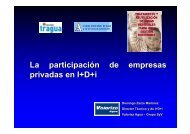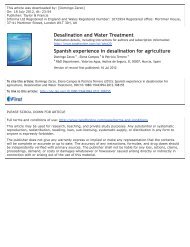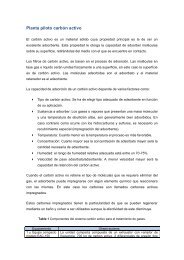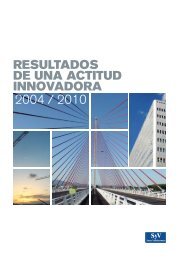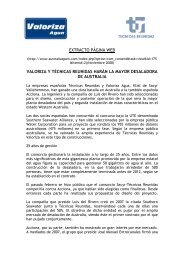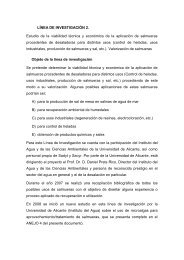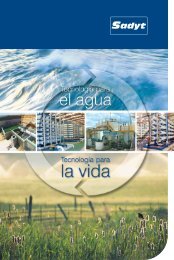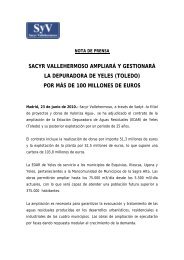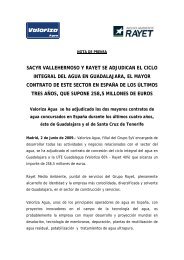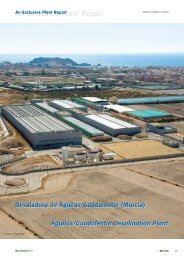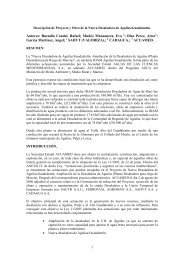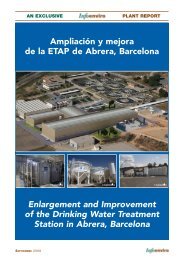Descargar - Valoriza Agua
Descargar - Valoriza Agua
Descargar - Valoriza Agua
Create successful ePaper yourself
Turn your PDF publications into a flip-book with our unique Google optimized e-Paper software.
Desodorización / Odour removal<br />
Investigación sobre la Medida y Caracterización de Olor en Estaciones<br />
Depuradoras de <strong>Agua</strong>s Residuales. Protocolo de Actuaciones<br />
Las fuentes de olor, su dispersión y la respuesta humana que estas generan dependen de una gran variedad de factores, por lo que determinar el grado<br />
de contaminación que provocan y la molestia ocasionada es muy complejo. Con el objetivo de profundizar en el análisis de la problemática de los malos<br />
olores en las EDARs y su impacto medioambiental, en el presente trabajo se realiza un estudio avanzado de los diferentes métodos y técnicas de<br />
medida y detección de olor. Se realiza el análisis combinado de métodos sensoriales y físico-químicos para la caracterización, diagnóstico y seguimiento<br />
de la generación del olor. Se propone un protocolo de actuaciones para la evaluación rápida y el control eficiente de las instalaciones. Todo ello sobre la<br />
base del estudio multidisciplinar realizado en la EDARi de la Fábrica de Helados de San Vicente del Raspeig, Alicante, España.<br />
M. Calzada, E. Campos y D. Zarzo Departamento de I +D + i, Sadyt – <strong>Valoriza</strong>. M. Ruiz y D. Prats,<br />
Inst. Univ. del <strong>Agua</strong> y Ciencias Medioambientales Campus San Vicente<br />
Research study on the measurement and characterisation of odours<br />
at WWTPs. Protocol of procedures<br />
The sources of odours, their dispersion and human response to them depend on a wide variety of factors. Therefore, determining the degree of pollution they<br />
cause and the nuisance created is very complex. With the objective of a deeper analysis of the problem of foul odours at WWTPs and their environmental impact,<br />
this research project entails an advanced study of the different odour detection and measurement methods and techniques. A combined analysis is carried out of<br />
sensory and physicochemical methods for the characterisation, diagnosis and monitoring of the generation of the odour. A protocol of procedures is proposed for<br />
the rapid evaluation and efficient control of facilities. All this is done on the basis of a multi-disciplinary study carried out at the IWWTP of the Fábrica de Helados<br />
de San Vicente del Raspeig (San Vicente del Raspeig Ice Cream Factory) in Alicante, Spain.<br />
M. Calzada, E. Campos and D. Zarzo Department of R&D&i, Sadyt – <strong>Valoriza</strong>. M. Ruiz and D. Prats,<br />
Institute of Water and Environmental Sciences, Univ. of Alicante, Campus San Vicente<br />
Introducción<br />
La actividad humana y la del propio medio natural hacen que estemos permanentemente<br />
expuestos a estímulos olfativos de todo tipo. Los procesos<br />
de tratamiento de aguas residuales son un claro ejemplo de la incidencia<br />
que tienen determinadas actividades en la generación de olores. Se ha<br />
avanzado mucho en la metodología de estudio de esta problemática<br />
(McGinley & McGinley, 2000 Aitken et al, 1992) y existen dos planteamientos<br />
para su análisis: la olfatometría, como parte de los métodos sensoriales,<br />
y el análisis estructural de los compuestos, como parte de los métodos<br />
químico-físicos (Nicolai & Pohl, 2005). En esta investigación hemos<br />
apostado por el análisis combinado de las dos.<br />
El estudio se llevó a cabo entre marzo de 2011 y junio de 2012 en la<br />
EDARi de la Fábrica de Helados Alacant y sus alrededores, que en ocasiones<br />
puntuales ha llegado a provocar las quejas de los vecinos por malos<br />
olores. Tiene una producción aproximada de 430 m 3 /día de agua tratada<br />
durante la temporada fabril. El proceso se lleva a cabo dentro de dos edificios<br />
contiguos, la nave de pretratamiento y la nave principal, realizándose<br />
básicamente el tratamiento con flotador por aire disuelto (DAF), biorreactor<br />
de membranas (MBR) soterrado (no techado), línea de tratamiento<br />
de fangos y almacenamiento de lodos en tolva. Cuenta con sistema de<br />
desodorización por carbón activo y captación por rejilla. (Figura 1)<br />
Metodología experimental<br />
Introduction<br />
Human activity and the natural environment itself cause us to be<br />
permanently exposed to olfactory stimuli of all kinds. Wastewater treatment<br />
processes are a clear example of the effect of certain activities on odour<br />
generation. Great progress has been made in the study methodology of<br />
this problem (McGinley & McGinley, 2000; Aitken et al, 1992) and there<br />
are two analysis approaches: the olfactometry approach, which belongs to<br />
the group of sensory methods, and structural analysis of compounds,<br />
which belongs to the area of physicochemical methods (Nicolai & Pohl,<br />
2005). In this study, we have opted for a combination of the two analysis<br />
approaches.<br />
The study was carried out between March 2011 and June 2012 at the<br />
Fábrica de Helados Alacant IWWTP and its surrounding areas, a facility that<br />
has on occasions provoked complaints of foul odours from neighbours.<br />
The plant has an approximate output of 430 m 3 /day of treated water<br />
during the manufacturing season. The process takes place in two adjacent<br />
buildings, the pre-treatment building and the main building. The treatment<br />
is basically carried out with a dissolved air floatation (DAF) unit,<br />
underground (unroofed) membrane bioreactor (MBR), sludge treatment<br />
line and sludge storage hopper. The facility has an activated carbon odour<br />
control system with a grid for air collection. (Figure 1)<br />
Experimental method<br />
Para la toma de muestras y mediciones in situ, se<br />
seleccionaron varios puntos en el interior de la planta<br />
y se tomaron medidas en el entorno más cercano.<br />
Para el estudio sensorial se utilizó el Nasal<br />
Ranger ® (olfatometría dinámica de campo) y el análisis<br />
de muestras con modelización (olfatometría dinámica<br />
de laboratorio). Para el estudio químico-físico<br />
se utilizaron: la cromatografía de gases, los analizadores<br />
portátiles, la nariz electrónica y el medidor<br />
de compuestos orgánicos volátiles (COVs).<br />
Métodos sensoriales<br />
El estudio olfatométrico se realizó siguiendo la metodología<br />
de las normas UNE-EN 13725 (AENOR,<br />
2004) y VDI 3940 (VDI, 2003). Para la evaluación<br />
de resultados, dado que en España no existe normativa<br />
vigente, se utilizaron distintos criterios como: la<br />
Normativa Holandesa (Ner, 2004), el Anteproyecto<br />
Figura 1. EDARi de la Fábrica de Helados Alacant:<br />
vista de proceso / Figure 1. Fábrica de Helados<br />
Alacant IWWTP: view of process.<br />
Several locations inside the plant were selected<br />
for sample taking and in situ measurements.<br />
Measurements were also taken in nearby<br />
surrounding areas. For the sensory study, the<br />
Nasal Ranger ® (dynamic field olfactometry) and<br />
the analysis of samples with modelling (dynamic<br />
laboratory olfactometry) were used. For the<br />
physicochemical study, the following tools were<br />
used: gas chromatography, portable analysers, the<br />
electronic nose, and the volatile organic<br />
compounds (VOCs) meter.<br />
Sensory methods<br />
The olfactometry study was carried out using<br />
methodology compliant with the UNE-EN 13725<br />
(AENOR, 2004) and VDI 3940 (VDI, 2003)<br />
standards. For results evaluation, given that<br />
currently there is no legislation in force in Spain,<br />
Septiembre / September 2012 81
Desodorización / Odour removal<br />
de Ley Catalana (Generalitat de Catalunya, 2010) y el protocolo FIDO de<br />
Socioenginyeria (Cid-Montañés et al, 2008).<br />
El olfatómetro de campo Nasal Ranger ® es un instrumento portátil que permite<br />
evaluar la intensidad de los olores ambientales mediante la técnica de<br />
“Dilución hasta el Umbral” (Nasal Ranger ® , 2011). Para el análisis en laboratorio<br />
de medidas de emisión, siguiendo la UNE-EN 13725, se identifican los<br />
principales focos y se toman las muestras con sondas y túnel de viento<br />
(Labaqua, S.A., 2011), la técnica utiliza el olfato humano como sistema de detección<br />
y un modelo matemático de dispersión, AERMOD; para reproducir el<br />
comportamiento en la atmosfera (EPA, 2004). Para el estudio en los alrededores<br />
se realizan las mediciones mediante percepciones en campo de panelistas<br />
calibrados, siguiendo la norma VDI 3940. Posteriormente se elabora el<br />
mapa de porcentaje de ocurrencia de olor con el programa SURFER.<br />
Métodos químico-físicos<br />
Con la cromatografía de gases se identifican los compuestos representativos<br />
y su concentración, empleando técnicas de muestreo discontinuo y de<br />
captación activa. (Kleeberg et al, 2005; AENOR, 1991). El sistema portátil<br />
de monitorización en continuo de alta precisión está constituido por el<br />
analizador Serinus 57 que mide azufre total reducido, TRS, y el analizador<br />
Serinus 44 que mide óxidos de nitrógeno (NO x ) y amoniaco (NH 3 ),<br />
ambos de ECOTECH. Los equipos trabajan en continuo y permiten observar<br />
la evolución en el tiempo de los compuestos así como su comportamiento<br />
ante diferentes eventos.<br />
La nariz electrónica es un dispositivo que funciona a través de unos sensores<br />
electroquímicos. El modelo E-Nose Mk4 BMS2, consta de seis sensores para<br />
distintos grupos de compuestos además de un sensor de temperatura y otro<br />
de humedad. Se ha calibrado para las condiciones particulares de la EDARi y<br />
permite obtener unidades de olor en tiempo real y contrastar sus resultados con<br />
los de la olfatometría dinámica. El medidor PhoCheck TIGER es un detector de<br />
gas portátil que utiliza la revolucionaria tecnología de foto-ionización (PID) para<br />
detectar una amplia gama de COV’s. Todas las lecturas de los sensores son medidas<br />
en tiempo real y los niveles de alarma se ajustan manualmente.<br />
Resultados y discusión<br />
Con el Nasal Ranger ® se realizaron 330 controles y 1974 lecturas en 6<br />
puntos dentro de la planta (1. Pretratamiento, 2. Tanque de lodos, 3.<br />
Centrifugado (parado y en marcha), 4. Biológico, 5. Flotador por aire disuelto<br />
(DAF), 6. Biorreactor de membranas (MBR)). Se realizaron además<br />
20 controles y 120 lecturas en 4 puntos de los alrededores. Los mapas de<br />
olores característicos, reflejan los valores de dilución hasta el umbral (D/T)<br />
y la correspondiente Unidad de Olor Europea (UO E /m 3 ) (Figuras 2 y 3).<br />
La campaña para el análisis en laboratorio contempló mediciones a la salida del<br />
sistema de desodorización, en el reactor biológico y en las puertas de acceso a<br />
las naves, como potenciales focos de emisión. El análisis de las muestras y la<br />
modelización condujeron a los resultados que se muestran en la figura 4.<br />
different criteria were used, including: the Dutch Standard (Ner, 2004), the<br />
Catalan Draft Bill (Generalitat de Catalunya, 2010) and the FIDO de<br />
Socioenginyeria protocol (Cid-Montañés et al, 2008).<br />
The Nasal Ranger ® olfactometer is a portable device that enables the<br />
evaluation of the intensity of ambient odours by means of “Dilution-to-<br />
Threshold” (Nasal Ranger ® , 2011) technology. For the laboratory analysis of<br />
emission measurements, in accordance with the UNE-EN 13725 standard,<br />
the main sources were identified and samples were taken with probes and<br />
wind tunnel (Labaqua, S.A., 2011). The technique uses the human nose as<br />
a detection system and a mathematical dispersion model, AERMOD, to<br />
simulate odour dispersion in the atmosphere (EPA, 2004). For the study of<br />
the surrounding areas of the IWWTP, measurements were taken through<br />
perceptions in the field of calibrated panellists in accordance with the VDI<br />
3940 standard. Subsequently, an odour occurrence percentage map was<br />
drawn up using the SURFER program.<br />
Physicochemical methods<br />
Gas chromatography enabled the identification of the main compounds<br />
and their concentration, using discontinuous sampling and active collection<br />
techniques. (Kleeberg et al, 2005; AENOR, 1991). The portable, highpressure<br />
continuous monitoring system is made up of the Serinus 57<br />
analyzer, which measures total reduced sulphur (TRS) and the Serinus 44<br />
analyzer, which measures nitrogen oxides (NO x ) and ammonia. Both units<br />
are manufactured by ECOTECH.<br />
The electronic nose is a device that functions by means of electrochemical<br />
sensors. The E-Nose Mk4 BMS2 has six sensors for different groups of<br />
compounds, in addition to a temperature sensor and a humidity sensor. It<br />
was calibrated for the specific conditions of the IWWTP and enables odour<br />
units to be obtained in real time and results to be cross-checked with those<br />
of dynamic olfactometry. The PhoCheck TIGER is a portable gas detector<br />
that uses revolutionary photo ionisation detection (PID) technology to<br />
detect a wide range of VOCs. All sensor readings are real time<br />
measurements and alarm levels are manually adjusted.<br />
Results and discussion<br />
330 controls and 1974 readings were taken with the Nasal Ranger ® at 6<br />
points inside the plant (1. Pre-treatment 2. Sludge tank 3. Centrifugation<br />
(idle and in operation) 4. Biological treatment 5. Dissolved air floatation<br />
(DAF) unit 6. Membrane bioreactor (MBR)). In addition, 20 controls were<br />
carried out and 120 readings taken at 4 locations in the surrounding areas<br />
of the plant. The characteristic odour maps show the dilution-to-threshold<br />
(D/T) values and the corresponding European Odour Unit (UO E /m 3 )<br />
(Figures 2 and 3).<br />
The laboratory analysis used measurements taken at the outlet of the<br />
odour control system, the bioreactor and the entrance doors to the<br />
Figura 2. Olfatometría de campo con el Nasal Ranger ® ,<br />
mediciones in situ por panelistas calibrados de SADYT / Figure 2.<br />
Field Olfactometry with the Nasal Ranger ® , in situ measurements<br />
with SADYT calibrated panellists.<br />
Figura 3. Izquierda: mapa de inmisión olores en el interior de la EDARi Helados Alacant; derecha: mapa de<br />
inmisión olores en los alrededores residenciales / Figure 3. Left: map of odour immissions within the Helados<br />
Alacant IWWTP; Right: map of odour immissions in the surrounding residential areas.<br />
82<br />
Septiembre / September 2012
Desodorización / Odour removal<br />
Para la campaña en campo se definió un área de estudio de 1,4 km x 1<br />
km, con una malla de 80 puntos y un tiempo de 26 semanas. En la figura<br />
5 se representan los diferentes niveles de porcentaje de tiempo de<br />
ocurrencia de olor a EDARi en la zona, considerando el número total de<br />
medidas realizadas. En ningún punto de la malla el tiempo de percepción<br />
fue superior al 10%.<br />
Los resultados con los diferentes métodos sensoriales demuestraron que,<br />
a pesar de encontrarse eventuales niveles de olor fuertes en pretratamiento<br />
y centrifugado (ver figura 3), y episodios puntuales en la descarga de la<br />
tolva de fangos o el MBR, los niveles de inmisión en los alrededores<br />
pueden considerarse “no desagradables” y cumplen con todas las normativas<br />
consideradas (ver figuras 4 y 5).<br />
Simultaneamente a los estudios anteriores, para el análisis cromatográfico<br />
de gases se tomaron de 2 a 5 muestras mensuales. Los resultados reflejaron<br />
la aparición de dos compuestos olorosos con mayores concentraciones,<br />
el limoneno principalmente en el pretratamiento y el indol principalmente<br />
en el MBR y en condiciones de mal funcionamiento. En la tabla<br />
1 se indican los valores medios resultantes del muestreo realizado.<br />
Figura 4. Modelización de las inmisiones EDARi Helados Alacant. UNE-EN 13725 /<br />
Figure 4. Modelling of immissions at the Helados Alacant IWWTP. UNE-EN 13725<br />
Con el sistema portátil de monitorización en continuo se pudo comprobar<br />
la evolución de las concentraciones de TRS, NO x y NH 3, y que la aparición<br />
de concentraciones elevadas estaba directamente relacionada con los momentos<br />
de la descarga de la tolva de fangos. Las mediciones con la nariz<br />
electrónica mostraron una tendencia similar a la registrada con el Nasal<br />
Ranger ® y su ventaja de trabajo en continuo sirvio como aviso instantáneo<br />
de alarma. Se realizaron 480 mediciones de COVs registrandose las mayores<br />
emisiones en la zona de pretratamiento y durante las descargas puntuales<br />
de la tolva de fangos, en el exterior las concentracoines se comportaron<br />
muy bajas o indetectables. A pesar de estos resultados se comprobó,<br />
mediante el contraste de ambos métodos, que no existe relación<br />
evidente entre la presencia de COV’s y la detección olfatométrica.<br />
Investigación actual en desarrollo<br />
Como parte de esta investigación se realiza además un estudio comparado<br />
a escala piloto del comportamiento de diferentes tecnologías de desodorización<br />
(tratamiento por vía química, vía biológica, adsorción por carbón<br />
activo y ozonización) con el objetivo de determinar tratamiento adecuado,<br />
eficiencia de eliminación, optimización técnico económica y posible<br />
combinación entre ellas. Los resultados y experiencias obtenidas serán<br />
dados a conocer en futuras publicaciones. (Figura 6)<br />
Conclusiones y propuesta de protocolo<br />
Con la utilización combinada de métodos de detección en este estudio, se<br />
han logrado la caracterización físico-química y sensorial del olor que genera<br />
la EDARi Helados Alacant, la identificación de los procesos que lo provocan<br />
y la evaluación de su incidencia en el entorno. Lo cual ha propiciado<br />
el diagnóstico y mejora de su proceso de producción e impacto social.<br />
En base a la experiencia desarrollada con los diferentes equipos implicados<br />
proponemos el siguiente protocolo de actuaciones para la evaluación<br />
y control eficiente de los olores de una EDAR en explotación:<br />
Figura 5. Mapa de porcentaje de tiempo de ocurrencia de olor de EDARi Helados Alacant<br />
VDI-3940 / Figure 5. Map of the percentage of odour occurance period at the Helados<br />
Alacant IWWTP VDI-3940<br />
buildings, which were regarded as potential emission sources. Sample<br />
analysis and modelling gave rise to the results shown in Figure 4.<br />
For the field campaign, a study area of 1.4 km x 1 km was defined, with a<br />
grid of 80 points and a time scale of 26 weeks. Figure 5 shows the different<br />
percentage levels of the odour occurrence period in the surrounding area of<br />
the WWTP, taking account of the total number of measurements taken. At no<br />
point of the grid did the perception period exceed 10%.<br />
The results with the different sensory methods demonstrate that, despite the<br />
occasional observance of strong odour levels in pre-treatment and<br />
centrifugation (see Figure 3), and specific cases at the location of the<br />
unloading of the sludge hopper and in the MBR, emission levels in the<br />
surrounding areas can be considered as “not unpleasant” and in compliance<br />
with all standards considered (see Figures 4 and 5). At the same time as the<br />
above studies took place, 2 to 5 samples per month were taken for<br />
chromatographic gas analysis. The results reflect the appearance of two<br />
Tabla 1. Muestreos y resultados de la cromatografía de gases de la zona de pretratamiento /<br />
Table 1. Samplings and results from gas chromatography in the pre-treatment area<br />
Compuesto / Metil Disulfuro Dimetil Etilbenceno / m,p-xileno / o-xileno / Limoneno / Indol /<br />
Compound mercaptano / de carbon / disulfuro / Ethylbenzene m,p-xylene o-xylene Limonene Indole<br />
Methyl Carbon Dimethyl<br />
mercaptan disulphide disulphide<br />
Valor medio<br />
(ppb, v/v) /<br />
Average value<br />
(ppb, v/v)<br />
2.75 148 30.6 40.9 140 86.5 825 1205<br />
Septiembre / September 2012 83
Desodorización / Odour removal<br />
• Evaluación de la planta y su entorno, para seleccionar los puntos de medida<br />
de emisión e inmisión de olor, mediante la percepción simple y<br />
teniendo en cuenta el grado de molestia<br />
• Caracterización sensorial y físico-química simultánea. Sensorial, mediante<br />
el olfatometro de campo Nasal Ranger ® . Físico-química, mediante sistema<br />
portátil de monitorización en continuo.<br />
• Contraste de resultados y definición de las actividades/episodios críticos<br />
o molestos siguiendo los criterios, recomendaciones y normativas vigentes.<br />
• Toma de medidas de corrección y propuesta de mejoras de funcionamiento.<br />
• Elaboración de un plan de control y seguimiento con apoyo del Nasal<br />
Ranger ® y la Nariz Electrónica.<br />
Referencias<br />
• AENOR (1991). UNE 77202. Calidad del aire. Determinación de compuestos<br />
de azufre en la atmósfera. Equipo de toma de muestras.<br />
• AENOR (2004). UNE-EN 13725. Calidad del aire. Determinación de la<br />
concentración de olor por olfatometríadinámica.<br />
• Aitken, M.D. y Okun, M.F.1992. Quantification of wastewater odors by<br />
the affected public. Water Environment Research. 64, pp 720-727<br />
• Generalitat de Catalunya, 2010. Avantprojecte de llei de qualitat odorífera.<br />
http://www20.gencat.cat/docs/dmah/Home/Ambits%20dactuacio/Atmosfera/Contaminacio%20odorifera/Avantprojecte%20de%20llei<br />
/avantprojecte.pdf (acceso 13/07/2012)<br />
• Cid-Montañéz J.F., Jorba R.,Tomás R., 2008. Effectiveness of field olfactometry<br />
and neighbor control to reduce odor annoyance from biosolids<br />
and MSW composting. Proceedings WEF/ A&WMA Odors and Air<br />
Emissions 2008 Conference, pp 331-344, Phoenix ( Arizona, USA)<br />
• EPA, U. S. Environmental Protection Agency, 2004. AERMOD: description<br />
of model formulation.EPA-454/R-03-004.<br />
http://www.epa.gov/scram001/7thconf/aermod/aermod_mfd.pdf (acceso<br />
27/07/2012)<br />
• Kleeberg K.K., Liu Y., Jans M., Schlegelmilch M., Streese J., Stegmann<br />
R., 2005. Development of a simple and sensitive method for the characterization<br />
of odorous waste gas emissions by means of solid-phase<br />
microextraction (SPME) and GC–MS/olfactometry. Hamburg University,<br />
Germany<br />
• Martínez J.V., Suárez C., Valor-Herencia I., Cortada C., 2004. Una Norma española<br />
para medir el olor: UNE-EN-13725. Ingeniería química. 412, pp 111-<br />
116. http://www.infoambiental.es/html/files/pdf/amb/iq/412/11ARTICULO-<br />
AB.pdf (acceso 14/08/2012)<br />
• Labaqua, S.A., 2011. Estudio de olores en el Campello. Informe<br />
1.074.403, Tunel de viento pp 83 – 105, Alicante, España.<br />
http://www.elcampello.es/upload/ficheros/medioambiente/ultimo-estudio-labaqua-pag-83-101.pdf<br />
(acceso 07/06/2012)<br />
• McGinley C.M., McGinley M.A., 2000. Field Odour Monitoring and<br />
Enforcement Presented at: the 22 nd Hawai Water Enivonnement<br />
Association Conference Honolulu, Hawai: 6-7 June.<br />
• Nasal Ranger®, 2011. http://www.nasalranger.com/ (acceso<br />
02/08/2012)<br />
• Nicolai R., Pohl, S., 2005. Understanding Livestock Odors. College of<br />
Agriculture & Biological Sciences. South Dakota State University. USA.<br />
http://www.sdstate.edu/abe/research/structures/upload/FS925-A.pdf,<br />
(acceso 22/08/2012)<br />
• Ner (Netherlands Emission Guidelines for Air), 2004. NL Agency,<br />
Ministry of Infrastructure and Environment. http://www.infomil.nl/english/subjects/air/netherlands-emission/<br />
(acceso 19/06/2012)<br />
• VDI, 2003. Bestimmung von Geruchsstoffimmissionen durch<br />
Begehungen - Bestimmung der Immissionshäufigkeit von erkennbaren<br />
Gerüchen - Rastermessung, Berichtigung zur Richtlinie Blatt 1,<br />
Deutschland. (Measurement of odour impact by field inspection -<br />
Measurement of the impact frequency of recognizable odours - Grid<br />
measurement, Corrigendum concerning guideline Part 1, Germany).<br />
http://www.vdi.de/401.0.html?&L=1&tx_vdirili_pi2%5BshowUID%5D=8<br />
9694 (acceso 22/08/2012)<br />
Figura 6. Vista general de las plantas pilotos de desodorización en la EDARi Helados Alacant /<br />
Figure 6. General view of the odour control pilot plants at the Helados Alacant IWWTP<br />
odorous compounds in high concentration; limonene, found mainly in pretreatment,<br />
and indole, found mainly in the MBR, and in condtions where<br />
the MBR was malfunctioning. Table 1 shows the average values from the<br />
sampling carried out.<br />
The portable continuous monitoring system enabled concentrations of TRS,<br />
NO x and NH 3 to be studied and it was observed that high concentrations<br />
coincided with the unloading of the sludge hopper. Measurements with the<br />
electronic nose showed similar trends to those registered with the Nasal<br />
Ranger ® and the advantage of its continuous operation was that it served as<br />
an instant alarm. 480 measurements of VOCs were recorded, with the<br />
highest emissions observed in the pre-treatment area and during the<br />
periodic unloading of the sludge hopper. Outside the plant, concentrations<br />
were found to be very low or undetectable. Despite these results, crosschecking<br />
of the two methods showed that there is no obvious relationship<br />
between the presence of VOCs and olfactometric detection.<br />
Research currently underway<br />
As part of this research project, a further comparative pilot-scale study is<br />
being carried out on the behaviour of different odour abatement<br />
technologies (chemical treatment, biological treatment, adsorption by<br />
activated carbon and ozonation) with the aim of determining appropriate<br />
treatment, removal efficiency, technical and economic optimisation, and the<br />
possible combination of such technologies. The results obtained and<br />
experiences will be revealed in future publications. (Figure 6)<br />
Conclusions and protocol proposal<br />
The use of combined detection methods in this study has enabled the<br />
physicochemical and sensory characterisation of the odour generated at the<br />
Helados Alacant IWWTP, the identification of the processes that cause this<br />
odour and the evaluation of its impact on the surrounding area. This has<br />
given rise to a diagnosis and enhancement of the production process and<br />
an improvement in social impact.<br />
Based on the results obtained, we propose the following protocol of<br />
procedures for efficient odour evaluation and control at an operative WWTP.<br />
• Evaluation of the plant and its surrounding area in order to select the<br />
locations for the measurement of odour emission and immission, by<br />
means of simple perception and taking account of the degree of nuisance.<br />
• Simultaneous sensory and physicochemical characterisation. Sensory<br />
characterisation by means of the Nasal Ranger ® field olfactometer.<br />
Physicochemical characterisation by means of the portable continuous<br />
monitoring system.<br />
• Cross-checking of results and definition of critical or nuisance<br />
activities/episodes in accordance with criteria, recommendations and<br />
current legislation and standards.<br />
• Taking of corrective measures and proposal of operational improvements.<br />
• Drawing up of a control and monitoring plan with the support of the Nasal<br />
Ranger ® and the Electronic Nose.<br />
84<br />
Septiembre / September 2012



